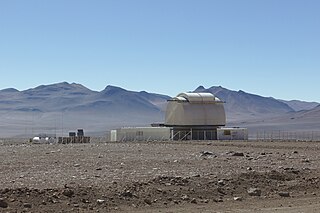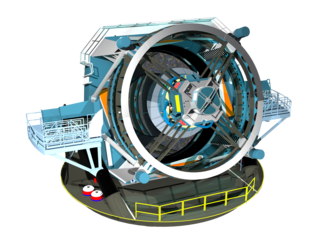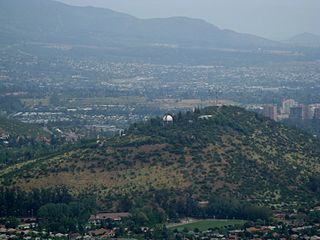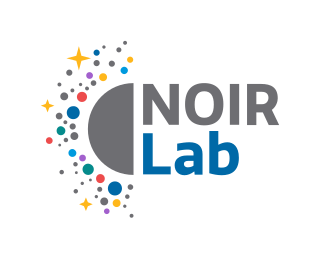Related Research Articles

The National Optical Astronomy Observatory (NOAO) was the United States national observatory for ground-based nighttime ultraviolet-optical-infrared (OUVIR) astronomy. The National Science Foundation (NSF) funded NOAO to provide forefront astronomical research facilities for US astronomers. Professional astronomers from any country in the world could apply to use the telescopes operated by NOAO under the NSF's "open skies" policy.

The Cerro Tololo Inter-American Observatory (CTIO) is an astronomical observatory located on the summit of Mt.Cerro Tololo in the Coquimbo Region of northern Chile, with additional facilities located on Mt. Cerro Pachón about 10 kilometres (6.2 mi) to the southeast. It is approximately 80 kilometres (50 mi) east of La Serena, where support facilities are located. The site was identified by a team of scientists from Chile and the United States in 1959, and it was selected in 1962. Construction began in 1963 and regular astronomical observations commenced in 1965. Construction of large buildings on Cerro Tololo ended with the completion of the Víctor Blanco Telescope in 1974, but smaller facilities have been built since then. Cerro Pachón is still under development, with two large telescopes inaugurated since 2000, and one in the final stages of construction as of 2023

The Association of Universities for Research in Astronomy (AURA) is a consortium of universities and other institutions that operates astronomical observatories and telescopes.
Carlos Torres (1929–2011) was a Chilean astronomer of the University of Chile and an individual member of the International Astronomical Union on several commissions. Between 1968 and 1982, he discovered or co-discovered a number of asteroids from the University of Chile's Cerro El Roble Astronomical Station. Together with Spanish astronomer Carlos Guillermo Torres (1910–1965), he was honored with the naming of asteroid 1769 Carlostorres.

Paranal Observatory is an astronomical observatory operated by the European Southern Observatory (ESO). It is located in the Atacama Desert of Northern Chile on Cerro Paranal at 2,635 m (8,645 ft) altitude, 120 km (70 mi) south of Antofagasta. By total light-collecting area, it is the largest optical-infrared observatory in the Southern Hemisphere; worldwide, it is second to the Mauna Kea Observatory on Hawaii.

The Southern Astrophysical Research (SOAR) telescope is a modern 4.1-meter (13 ft) aperture optical and near-infrared telescope located on Cerro Pachón, Chile at 2,738 metres (8,983 ft) elevation. It was commissioned in 2003, and is operated by a consortium including the countries of Brazil and Chile, Michigan State University, the Cerro Tololo Inter-American Observatory (CTIO), and the University of North Carolina at Chapel Hill. Partners have guaranteed shares varying from 10 to 30 percent of the observing time.

Llano de Chajnantor Observatory is the name for a group of astronomical observatories located at an altitude of over 4,800 m (15,700 ft) in the Atacama Desert of northern Chile. The site is in the Antofagasta Region approximately 50 kilometres (31 mi) east of the town of San Pedro de Atacama. The exceptionally arid climate of the area is inhospitable to humans, but creates an excellent location for millimeter, submillimeter, and mid-infrared astronomy. This is because water vapour absorbs and attenuates submillimetre radiation. Llano de Chajnantor is home to the largest and most expensive astronomical telescope project in the world, the Atacama Large Millimeter Array (ALMA). Llano de Chajnantor and the surrounding area has been designated as the Chajnantor Science Reserve by the government of Chile.

The NANTEN2 Observatory is a southern sky observatory in the Atacama Desert of northern Chile. It is located at an altitude of 4,800 m (15,748 ft) on Pampa la Bola next to Cerro Chajnantor. The observatory is equipped with a millimeter and submillimeter wave telescope that is used for southern sky observations of atomic and molecular spectral lines in 110 GHz to 880 GHz range. It is one of a number of observatories operating at Llano de Chajnantor Observatory. It is operated as a collaboration between research institutes in Japan, South Korea, Germany, Australia and Chile.

The Atacama Submillimeter Telescope Experiment (ASTE) is a 10-meter-diameter antenna built by Mitsubishi Electric as a preprototype for ALMA.

The Vera C. Rubin Observatory, previously referred to as the Large Synoptic Survey Telescope (LSST), is an astronomical observatory currently under construction in Chile. Its main task will be carrying out a synoptic astronomical survey, the Legacy Survey of Space and Time. The word synoptic is derived from the Greek words σύν and ὄψις, and describes observations that give a broad view of a subject at a particular time. The observatory is located on the El Peñón peak of Cerro Pachón, a 2,682-meter-high mountain in Coquimbo Region, in northern Chile, alongside the existing Gemini South and Southern Astrophysical Research Telescopes. The LSST Base Facility is located about 100 kilometres (62 mi) away by road, in the town of La Serena. The observatory is named for Vera Rubin, an American astronomer who pioneered discoveries about galaxy rotation rates.

Miñiques is a massive volcanic complex containing a large number of craters, lava domes and flows, located in the Antofagasta Region of Chile. Located 21 km (13 mi) south of Volcán Chiliques and 26 km (16 mi) west of Cordón Puntas Negras, it is part of a frequently visited attraction conformed by the high plain lagoons Laguna Miscanti, Laguna Miñiques and the Cerro Miscanti volcano.
The University of Toronto Southern Observatory (UTSO) was an astronomical observatory built by the University of Toronto at the Las Campanas Observatory in Chile. It hosted a single 60 cm Cassegrain telescope and a small cottage for the operators, located amongst the instruments funded by other organizations. The first observational runs started in 1971, and like many smaller instruments, it was later shut down in favor of a partial share in a much larger telescope in 1997. Although small by modern standards, the Southern Observatory nevertheless became famous for its role in the discovery of SN 1987A when UofT astronomer Ian Shelton spotted the supernova while observing with another little-used telescope at the site.
The Magellanic Cloud Emission Line Survey (MCELS) is a joint project of Cerro Tololo Inter-American Observatory (Chile) and the University of Michigan using the CTIO Curtis/Schmidt Telescope. The main goal of the project is to trace the ionized gas in the Magellanic Clouds using narrow-band filters and investigate the physical properties of the interstellar medium of these galaxies. Those emission lines are produced by different astrophysical objects and processes.

In 2011, Chile was home to 42% of the world's astronomical infrastructure, consisting principally of telescopes. In 2015, it was estimated that Chile would contain more than 50% of the global astronomical infrastructure by 2030. In the Atacama desert region of northern Chile, the skies are exceptionally clear and dry for more than 300 days of the year. These conditions have attracted the world's scientific community to develop highly ambitious astronomical projects in the Atacama desert.

The Calán/Tololo Supernova Survey was a supernova survey that ran from 1989 to 1995 at the University of Chile and the Cerro Tololo Inter-American Observatory to measure a Hubble diagram out to redshifts of 0.1. It was founded by Mario Hamuy, José Maza Sancho, Mark M. Phillips, and Nicholas B. Suntzeff in 1989 out of discussions at the UC Santa Cruz meeting on supernovae on how to improve the Hubble diagram using Type Ia supernovae. It was also motivated by the suggestion of Allan Sandage to restart a supernova survey after the Sandage and Tammann survey failed due to poor quality photographic plates in 1986. The Survey built on the original supernova survey of Maza done at the f/3 Maksutov Camera at the Cerro Roble Observatory of the University of Chile between 1979 and 1984. The Survey used the CTIO Curtis Schmidt telescope with IIa-O photographic plates, each plate covering a field of 25 sq-deg on the sky. The plates were developed and sent to Santiago Chile the next morning and searched for supernovae at the Department of Astronomy at the University of Chile. Any supernova candidates were then observed the next night using the 0.9m telescope at CTIO with a CCD camera. This was one of the first studies done in astronomy where the telescope time was scheduled to observe objects not yet discovered.

Cerro Armazones is a mountain located in the Sierra Vicuña Mackenna of the Chilean Coast Range of Andes, approximately 130 km (81 mi) south-east of Antofagasta in the Antofagasta Region, Chile. The mountain is located in a privileged zone for optical astronomy because it has 89% cloudless nights a year. On 26 April 2010, the European Southern Observatory Council selected Cerro Armazones as the site for the planned Extremely Large Telescope (ELT); the construction began in June 2014, and the first light is expected in 2027. Before the construction of the ELT began, the elevation of Cerro Armazones had been 3,064 metres (10,052 ft), but now the top is truncated and the resulting plateau is several meters lower.

The National Astronomical Observatory of Chile is an astronomical observatory owned and operated by the Department of Astronomy of the University of Chile (UCh). It is located on Cerro Calán, a hill in the commune of Las Condes. The commune is an eastern suburb of Santiago located in Santiago Province of the Santiago Metropolitan Region. OAN was founded in 1852 and became a part of UCh in 1927. The facility on Cerro Calán was completed in 1962.

Charles Mattias ("Matt") Mountain is currently the President of the Association of Universities for Research in Astronomy (AURA) which designs, builds, and operates telescopes and observatories for the National Science Foundation (NSF) and the National Aeronautics and Space Administration (NASA). AURA's NASA center is the Space Telescope Science Institute (STScI), responsible for the science mission for the Hubble Space Telescope, the science and operations for the James Webb Space Telescope, and the MAST data archive. AURA's NSF centers are Gemini Observatory, the National Optical Astronomy Observatory (NOAO), and the National Solar Observatory (NSO). Dr. Mountain and AURA are also responsible for the NSF construction projects: the Daniel K. Inouye Solar Telescope (DKIST) on Haleakalā, Hawaii and the Large Synoptic Survey Telescope (LSST) on Cerro Pachón in Chile.

NSF’s NOIRLab is a United States federally funded research and development center for ground-based, nighttime optical and infrared astronomy.
CHILESCOPE is the remote observatory is located in the Chilean Andes at an elevation of 1,560 meters. Observatory is located in the southern part of the Atacama Desert, some 12.5 miles southeast of Cerro Pachon. The mountain upon which the domes are located is actually owned and shared by two observatories: Chilescope and Obstech. The staff of both observatories work closely together.